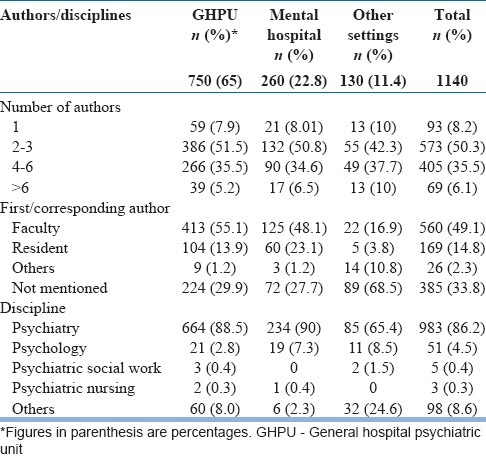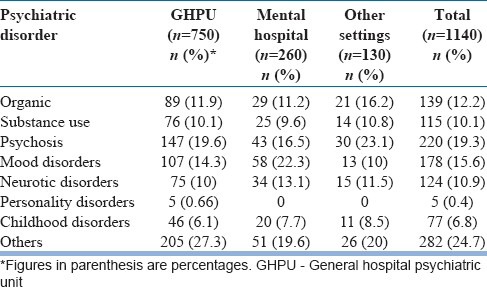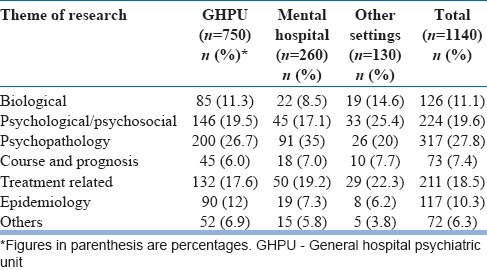Abstract
Background:
General hospital psychiatric units (GHPUs) are one of the major service and training providers in the field of mental health in India. However, there has not been any systematic attempt at their contributions toward research.
Aim:
The present paper reports on contributions of the GHPUs toward the psychiatric research based on analysis of publications in the Indian Journal of Psychiatry (IJP).
Materials and Methods:
All the issues of IJP of the last 25 years (1989-2013) were manually searched for original research papers, brief reports, and case reports. A semi-structured performa was used to collect information on various parameters.
Results:
About two-thirds of the papers were contributed by the GHPUs, most being multi-authored and from tertiary care centers. The research covered a variety of psychiatric disorders including schizophrenia, mood disorders, and common mental disorders. Most of the research reported was self-funded.
Conclusion:
GHPUs have contributed significantly to psychiatric research in India in the last 25 years.
Keywords: General hospital psychiatric unit, GHPU, India, psychiatry, research
INTRODUCTION
In India, mental health services are available in different settings such as mental hospitals, general hospital psychiatric units (GHPUs), psychiatric nursing homes and office based practice. Compared to most of the western world, GHPUs are the main service providers for mental health care. GHPUs attend to patients with almost all kinds of mental disorders ranging from organic brain disorders such as dementia, delirium, substance use disorders to schizophrenia, and related psychotic disorders, mood disorders, anxiety disorders, somatoform disorders, psychosomatic disorders, personality disorders, psychosexual disorders, sleep disorders, disorders specific to childhood, and adolescence, psychiatric emergencies, and others.
In the last eight decades since the start of first GHPU at Kolkata in 1933, the GHPUs have established themselves as an alternative to the mental hospitals. GHPUs are associated with a hub of activities related to mental health such as clinical care, training, and research in India. Being located in a general hospital amongst various other medical specialties, GHPUs offer many advantages such as easy accessibility, lesser stigma, treatment facility for comorbid physical illnesses in the same premises, collaborative research and comprehensive training opportunities for undergraduate and postgraduate students in psychiatry and behavioral sciences. The development of GHPUs was, in fact, a revolutionary development in the field of psychiatry in India.[1]
Psychiatric research in India has come a long way with more and more of it being data based especially in the last four decades, compared with the theoretical research of 1950s and 1960s. Recently, the Indian Journal of Psychiatry (IJP), the official journal of the Indian Psychiatric Society (the national body of psychiatrists in India) came out with a comprehensive supplement on different aspects of psychiatric research in India.[2,3] The supplement covered a wide range of topics, especially the Indian research in earlier decades and international perspective in relation to the SAARC, Asian and some of the western countries. There were papers summarizing the Indian research on different psychiatric disorders, covering special populations, and also on mental health resources. Some of the contributions covered the future of psychiatric research, and improving on the research design, and training. Certain other authors in the past have also written extensively on issues related to psychiatric research in India.[4,5,6,7]
Although the subject of psychiatric research in India has been covered in a number of papers, there is no literature available on the relative contribution of various mental health settings to psychiatric research in India. It is a known fact that GHPUs have made significant contributions to psychiatric research in India,[8] but a systematic review on the subject is lacking.
Research helps in identification of various problems affecting the growth and development in a particular area.[9] It is also an indicator of various activities being carried out in that particular setting. Thus, a review of research in GHPUs would help in identifying the areas needing more focus and providing potential for further improvement. In the above background, the present review was undertaken with an aim to document the contributions of GHPUs to the psychiatric research in India.
MATERIALS AND METHODS
Indian Journal of Psychiatry, the official journal of the Indian Psychiatric Society is more than 60 years old and publishes four issues every year. All issues of the journal, published over a period of 25 years from 1989 to 2013 were manually searched. Original papers, brief research communications and case reports published during the period were screened for the study. A semi-structured performa was used to collect information on various parameters such as subject area of research, study population, research design, details about authors like their discipline, designation, and institutional affiliation, single center or multicentric nature of the study and funding agency, if any. Abstract of each paper, and when necessary, full text was screened. Discrepancy, if any, was resolved by consensus. The frequency of research contributions was compared between GHPUs, mental hospitals and other settings.
RESULTS
A total of 1140 publications were retrieved, out of which 769 (67.5%) were original papers, 58 (5.1%) were brief research communications, and 313 (27.5%) were case reports. About two-third of the papers (65.6%) came from GHPUs, one-fifth (22.5%) were from mental hospitals and the rest were from other settings like nongovernmental organizations (NGOs) or from other countries. Eighty-six percent of the publications were multi-authored. In about half (49.1%) of the papers, the lead author was a faculty or consultant. In most (86%) of the papers, the lead author was a psychiatrist. Most (83.9%) research came from tertiary care centers. Most of the research was self-funded, and only 2.7% of the research was supported by national or international funding. Only 3% of the research was multicentric. The research covered a variety of psychiatric disorders including psychoses, mood disorders, and common mental disorders. The studies were conducted across varied themes covering biological, psychosocial, epidemiology, psychopathology, and treatment related aspects.
In most of the papers from the GHPUs, the lead author was a psychiatrist (88.5%), faculty member for about half of the papers (55.1%), and residents for 13.9% of the articles. For about half of the papers (51.5%), number of authors was two or three and for about one-third (35.5%), it was four to six. When a comparison was made amongst the contributions from different settings, there was lesser number of residents from GHPUs and other settings as lead authors in comparison to mental hospitals. Number of psychologists being a lead author was more [Table 1].
Table 1.
Characteristics of authors and their affiliation

About one-third (33.9%) of the papers from the GHPUs were about psychoses and mood disorders There was not much difference across different settings regarding the type of psychiatric disorders [Table 2]. The theme of research for one-fourth (26.6%) of papers from GHPUs was on psychopathology, one-fifth (19.5%) on psychological and psychosocial issues, and one-sixth (17.6%) papers were on treatment related issues. On a comparison with papers from other settings, only minor differences were observed [Table 3].
Table 2.
Subject area of research across different settings

Table 3.
Theme of research across different mental health settings

Most (83.2%) of the studies from GHPUs were based on the clinical population in the tertiary care centers, while only about 9% had been conducted in the general population. Multicentric studies were very few (2.3%). A small number (1.7%) of the studies were funded by national or international agencies. Nearly half of the studies were cross-sectional in design. On comparison of research from GHPUs with that from mental hospitals and other settings, general population studies, multicenter research and studies with the longitudinal design were more often from other mental health settings than the GHPUs. Share of funding from national or international agencies was least for the GHPUs (1.5%) and was maximum for other mental health settings (7%) [Table 4].
Table 4.
Research design of studies across different mental health settings

DISCUSSION
GHPUs contributed to nearly two-third of the research in mental health in the last 25 years, as evidenced by the publications in the IJP, the leading journal of psychiatry from India. The publications covered original research, brief research communications and case reports. Publications from GHPUs were 3 times the number of those from the mental hospitals, the leading provider of mental health services in the earlier era. About one-tenth of the research contributions came from other settings like NGOs, voluntary sector, private sector or from other countries.
The major difference in contribution to the research from the GHPUs and mental hospitals could be due to multiple reasons. In the last few decades, there has been an increasing focus on the development of GHPUs in comparison to mental hospitals. Reason for this development has been opening of many new medical schools since 1960s, where GHPUs were established as part of the general hospitals as well for undergraduate training in psychiatry. GHPUs have also seen a steady increase in beds and many of them are also providing postgraduate training in psychiatry. A research dissertation is an essential part of the postgraduate curriculum. Most of the new postgraduate training centers are located in the GHPUs. All these factors have led to an increasing research contribution and publications from the GHPUs. GHPUs also offer opportunities for collaborative research with other medical disciplines, being a part of multidisciplinary hospital. In contrast, there has not been any major increase in beds in the mental hospitals in the last 50 years in India. Though many mental hospitals, which were earlier not involved in postgraduate teaching, have also initiated postgraduate training, their growth has not been as exponential as of GHPUs.
Most of the published research from GHPUs was multi-authored, with a senior psychiatrist or a faculty member being the lead author. However, one encouraging trend was that in 14% of the publications from GHPUs and 23% of the papers from mental hospitals, a young trainee or resident was the first author. This shows that our younger colleagues are also taking initiative in publishing their research work. But it is a known fact that (though not documented) most of the research conducted by residents during postgraduate training remains unpublished. The senior members of the profession need to constantly encourage the younger generation, so that the research initiatives taken by the young postgraduate trainees should not go waste.
Most publications from the GHPUs were contributed by the psychiatrists. This is understandable, but mental health is a multidisciplinary field also involving nonmedical disciplines such as clinical psychology, psychiatric social work and nursing. In India, GHPUs are generally small psychiatry departments in medical colleges with 2-3 psychiatrists, and most lack psychologists and psychiatric social workers. Ideally, a GHPU should have at least three psychiatrists, clinical psychologists, psychiatric social workers, and psychiatric nurses. But most of the departments have a small faculty comprising of only 2-3 psychiatrists and a few nurses. This might have resulted in poor representation of other disciplines in the publications.
About one-third of the papers from GHPUs were on psychoses and mood disorders. This trend was reflected across different mental health settings. There were minor differences across different settings in the disorders covered and the theme of research. Interestingly the number of papers on neurotic disorders were more from mental hospitals and on psychoses more papers were from GHPUs. This also means that the difference in the clinical profile of patients seen across different mental health settings is coming down. This finding also challenges the fact that the mental hospitals attend only to patients with severe mental illnesses. Unlike the western countries, GHPUs in India are providing continued care to patients with all types of psychiatric disorders, which include emergency care, hospitalization for few weeks and long-term follow-up.
Most publications from GHPUs were from tertiary care centers, mainly the medical colleges, which was as expected. Most of the research from GHPUs was self-funded with very few papers originating from funded research. The reason could be due to limited funding for mental health research from different government agencies like the Indian Council of Medical Research, Department of Science and Technology, etc., It is also possible that the researchers, who get funding, tend to publish their research elsewhere. There was a lack of collaborative research with only few multicenter studies done in collaboration with other centers in India or other countries. This is not a healthy trend and the researchers in GHPUs need to plan multicenter collaborative research, which is likely to give robust findings, which could be of benefit to the profession.
GHPUs in India attend to a significant number of patients, but the number of beds in general hospitals (10,000; 0.8/100,000 population) is far less than the mental hospitals (17,835; 1.4/100,000 population).[10] This is understandable considering that GHPUs often have shorter admissions compared to the mental hospitals. However, GHPUs have contributed significantly to increase in trained mental health power through training of undergraduates and postgraduates, thus helping in realization of objectives of the National Mental Health Program (NMHP) (1982)[11] like integration of mental health into general health care and promotion of community participation. However, until recently, the GHPUs have been neglected, and government has not provided adequate funding for their growth. Funds allocated to GHPUs are far less than those of mental hospitals and other mental health settings. Furthermore, the GHPUs have minimal influence on various policy issues. Even within general hospital settings, psychiatric services are ignored with more emphasis on other departments. In the recent mental health atlas 2011[10], no information is available about GHPUs except for number of beds. Thus, there is an increasing need by the mental health policy makers to enhance the budgetary allocations to the GHPUs and to increase the manpower in the GHPUs. The NMHP of India in the last few years has provided some support to the GHPUs in this direction, but the area is still a neglected one.
Authors don’t claim this paper as a systematic review, since the paper did not include publications from journals which would have given a more holistic description of the contribution from GHPUs. However, a similar trend is likely, if one goes into a more extensive review of publications from the other journals including the regional ones, international journals and journals covering broad medical subjects including psychiatry.
CONCLUSION
The present paper is an attempt to document the contributions of GHPUs to psychiatric research in India. About two-thirds of papers in IJP in the last 25 years were from GHPUs. The research is mostly self-funded, and tertiary care based. The papers are mostly multi authored and by senior psychiatrists. The study shows that the GHPUs have contributed significantly to psychiatric research in India.
Footnotes
Source of Support: Nil
Conflict of Interest: None declared
REFERENCES
- 1.Wig NN. Psychiatric units in general hospitals - Right time for evaluation. Indian J Psychiatry. 1978;20:1–9. [Google Scholar]
- 2.Rao TS, Swaminath G, Rao GP. Indian psychiatry and Indian journal of psychiatry - A journey. Indian J Psychiatry. 2010;52:S1–6. doi: 10.4103/0019-5545.69194. [DOI] [PMC free article] [PubMed] [Google Scholar]
- 3.Indian Journal of Psychiatry. [Last accessed on 2014 May 30];2010 52(Suppl):1–401. Available from: http://www.indianjpsychiatry.org/showBackIssue.asp?issn=0019-5545;year=2010;volume=52;issue=7;month=September;supp=Y . [Google Scholar]
- 4.Wig N, Akhtar S. Twenty-five years of psychiatric research in India (a reappraisal with some suggestions for the future) Indian J Psychiatry. 1974;16:48–64. [Google Scholar]
- 5.Trivedi JK. Fifty years of psychiatric research in India. Indian J Psychiatry. 1997;39:1–2. [PMC free article] [PubMed] [Google Scholar]
- 6.Andrade C, Kiran S, Rao SK, Choudhury P. Do Indian researchers read Indian research. A reappraisal, four years later? Indian J Psychiatry. 2000;42:203–8. [PMC free article] [PubMed] [Google Scholar]
- 7.Patel V, Kim YR. Contribution of low- and middle-income countries to research published in leading general psychiatry journals, 2002-2004. Br J Psychiatry. 2007;190:77–8. doi: 10.1192/bjp.bp.106.025692. [DOI] [PubMed] [Google Scholar]
- 8.Wig NN, Awasthi A. Origin and growth of general hospital psychiatry. In: Agrawal SP, Goel DS, Ichpujani RL, Salhan RN, Shrivastava S, editors. Mental Health: An Indian Perspective, 1946-2003. New Delhi: Directorate General of Health Services Ministry of Health and Family Welfare; 2004. pp. 101–8. [Google Scholar]
- 9.Sharan P, Gallo C, Gureje O, Lamberte E, Mari JJ, Mazzotti G, et al. Mental health research priorities in low- and middle-income countries of Africa, Asia, Latin America and the Caribbean. Br J Psychiatry. 2009;195:354–63. doi: 10.1192/bjp.bp.108.050187. [DOI] [PMC free article] [PubMed] [Google Scholar]
- 10.World Health Organization Mental Health Atlas 2011-Department of Mental Health and Substance Abuse, World Health Organization. [Last accessed on 2014 Jun 05]. Available from: http://www.who.int/mental_health/evidence/atlas/profiles/ind_mh_profilepdf?ua=1 .
- 11.National Mental Health Programme. [Last accessed on 2014 Jun 05]. Available from: http://www.mohfw.nic.in/WriteReadData/l892s/9903463892NMHP%20detail.pdf .


